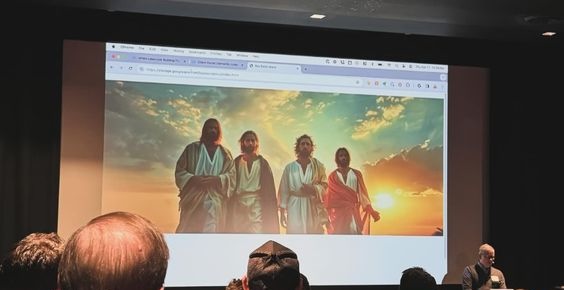In my presentation at Zenith I demonstrated how to use AI tools to rapidly create content that can quickly be deployed on the internet.
Using text and video tools, I was able to show the audience in a pretty amusing – amusing for me at least – way how to take an idea and turn it into live content in a very short period of time.
In essence I had a presentation that I was going through and while I was going through it I took some breaks to get input from the audience. Below I’ve got more detail about what that looked like.
I can’t even tell you how long I’ve been going to the Zenith Digital Marketing Conference in Duluth.
Marty Weintraub of Aimclear has been organizing this conference in association with the Duluth Chamber of Commerce’s young professionals organization, Fuse, for many years.
The quality of speakers Marty brings to small-town Duluth rivals some of the best-known conferences in America.

Me, Mike King, and Marty Weintraub. Yes, Mike really is that tall. Or maybe, Marty and I..
And, Marty’s team, family, and friends I only see in Minnesota are some of the best people around!
This year, I was presenting concepts for AI content repurposing.
I had a presentation that I had been working on for a while, which I knew would be a bit short for the time allotted. I wanted to give real examples of how one can use AI to repurpose content.
To demonstrate content repurposing, I used my existing presentation, which you can see at https://www.searchinfluence.com/ai-content/ and I added a live demonstration.
I’ve also written up some of these concepts in my article on AI Content Repurposing for Search Engine Land.
At the start of the presentation I asked volunteers from the audience to propose a search term and a target URL.
During the presentation, I used a tool that I’m very fond of called ZimmWriter to produce three original pieces of content and simultaneously used a tool called Wave.video to make videos of those same content articles.
I then published the articles created by ZimmWriter to a few different websites, the Wave.video videos to YouTube. I also linked to the articles from the videos and embedded the videos in the article.
While I used the concept of a new keyword and generated new articles, this is something I’ve been doing quite a lot in the context of repurposing content.
My position is that if you are starting from content that you originally created and making derivative copies for publication and syndication, then it’s not much different than using social media or a secondary blog post to promote your content. The difference is that you’re using AI tools to create those derivative pieces of content and linking back from those.
A big benefit of Google properties like YouTube and Google Business posts and others is that they increase the likelihood and rate of indexation of the content.
In some instances, the derivative pieces of content published on Google properties can rank themselves.
The three search terms I used were:
Since there was no original content to start from, I had ZimmWriter use its internal research tools to derive the information that was turned into the articles.
I then published each of the articles on different sites, created the videos in Wave.video, and published them to YouTube, linking back.
Interestingly, the only one that appears to be ranking is the video created for KitchenAid Pizza Dough, the title of which was “KitchenAid Pizza Dough Tips & Tricks.”
I was given some feedback that I could have done a better job contextualizing the exercise for some of the less SEO-savvy in the audience.
One specific comment was that it wasn’t clear when I talked about links that what I really meant was backlinks.
Aside: I just don’t love the term backlinks. It sounds too SEO-y to me. I prefer to differentiate between links and internal links, but whatever
With that in mind, I got positive feedback that I did a good job demonstrating how quickly and easily one can use AI tools to create content that actually shows up in the search engines.
Another funny side story, which Lily Ray mentioned in Instagram post following the event, was that I had on-screen some images that I had rendered for a silly project that came from too much wine drinking with fellow SEOs.

Lily told the story of an AirBnB that she had stayed in where there was a picture of a cute guy on the bulletin board by the door. She only realized later that the cute guy was actually Jesus.
She described him as kind of a boy band version of Jesus. Hilarity ensued, and I rendered some images of what a boy band Jesus might look like and then, as these things happen, I had to build a website.
To be fair, I waited until the next morning in case anyone else wanted the domain and when it was still available at 7 the next day I jumped on it.
So, if you’d like another example of AI content, feel free to check out https://boybandjesus.com.
I know that this tactic of using AI tools to repurpose content may be a little close to the line for some people. My internal rationalization is that when you start from your own material and you give attention to editing and ensure that you’re not using other resources it’s not spam.
Instead, it’s a more efficient means of content syndication.
Be sure to check out the videos and the content pieces that they link to; these were published almost completely unedited.
The one exception is the professional résumé writer article. ZimmWriter, in its research, which is effectively looking at the top-ranking sites on Google, picked up on a brand name as an authoritative source for professional writing.
In the interest of not promoting that brand that I don’t endorse, I did some minor editing to remove that brand name from the content that was created.
I’m interested in your thoughts. Please do share.
